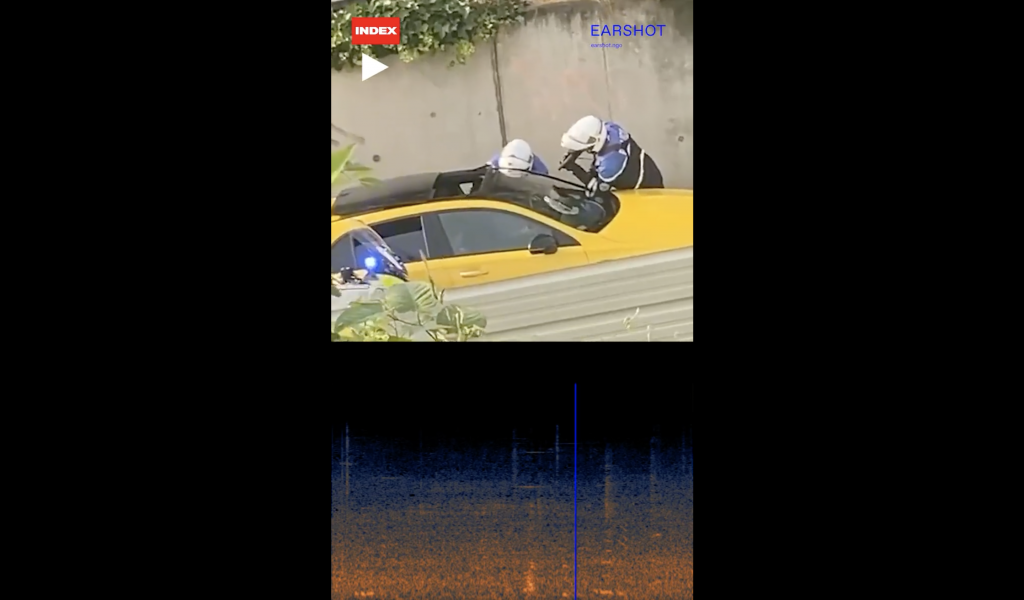Politics
A Group Led by Artist Lawrence Abu Hamdan Is Analyzing an Audio Recording of a French Teen’s Fatal Encounter With Police
The group, Earshot, has unearthed new details about the incident by enhancing the audio from a witness's video.

The group, Earshot, has unearthed new details about the incident by enhancing the audio from a witness's video.

Taylor Dafoe

An artist-founded audio investigation group has shared an analyzed recording of Nahel M.’s death at the hands of a police officer last month.
The 17-year-old victim was fatally shot after being stopped by police in the Paris suburb of Nanterre on June 27. Violent protests and riots erupted across France in the following days.
Accounts of what happened during the traffic stop differ. The public prosecutor of Nanterre has contended that the officer fired after Nahel, the driver, attempted to flee, or even run over the police. But a passenger in the car maintained that Nahel only let his foot off the car’s brake after being hit by the officer, who fired as the vehicle rolled away.
According to the IGPN, France’s national police, one of the police officers yelled, “Coupe! Les mains derrière la tête,” or “Cut! Hands behind your head.”
But audio released late last week by Earshot, an “investigative agency that employs cutting-edge audio analysis techniques” founded by Turner Prize-winning artist Lawrence Abu Hamdan, appears to contradict IGPN’s account. The recording, which was taken from a witness’s video, could even indicate an intention to kill, according to the group.
“There has been a lot of speculation about what was said by the police officers before they shot Nahel point blank,” Abu Hamdan wrote in an Instagram post. “This video is an effort to make available an enhanced audio signal of the event and increase the resolution of these debates.”
Earshot’s analysis of the moments leading up to Nahel’s death revealed two audible phrases, both uttered by the same officer: “Ouvre, ouvre” (“Open, open”) and “Pousse-toi” (“Move over”). Abu Hamdan pointed out that the words were spoken in the informal French, which is unconventional for police interactions.
“Though ‘Ouvre, ouvre’ could be directed at Nahel (instructing him to open his car door), ‘Pousse-toi’ (‘move over’) does not make sense in the context where a gun is pointed at him and the police are leaning on his car,” the artist continued. “An alternate thesis could be that the ‘Pousse-toi’ is the gunman’s address to his colleague, instructing him to move out of the way of the shot to come.”
If true, Abu Hamdan said, “this would indicate the killing was pre-determined.”
🔎 Homicide de #Nahel à #Nanterre : Premiers éléments d’analyse audio des mots prononcés par les policiers juste avant le coup de feu.
👉 En partenariat avec https://t.co/7uktiV1SPl et @LAbuHamdan. pic.twitter.com/pWlXA6Dt6U
— INDEX (@index_ngo) June 30, 2023
INDEX, a French investigative NGO that is conducting the audio research in partnership with Earshot, wrote in a statement on its website saying that “the analysis is in progress and does not, in our opinion, allow us to make a formal statement on the content of the oral exchanges that took place in the moments preceding the shooting.” (INDEX brands itself as a “stand-alone extension” of Forensic Architecture, where Abu Hamdan is also a research fellow.)
Despite the apparent lack of conclusive evidence, the NGOs’ audio has been picked up by numerous news outlets, adding fuel to a fiery public debate over the circumstances around Nahel’s death and the broader issue of police brutality in France.
According to a July 3 tweet from INDEX, the TV station Info France 2 aired the groups’ audio analysis, albeit with captions from IGPN’s transcript. “You make him say the OPPOSITE of our analysis,” INDEX wrote in the post, which has been viewed over 1.6 million times. The next day, Info France 2 apologized for its “inappropriate use” of the audio.
More Trending Stories:
A Norwegian Dad Hiking With His Family Discovered a Rock Face Covered With Bronze Age Paintings
Lisa Schiff Questioned the Validity of Art Appraisals. Days Later, She Was Sued for Fraud